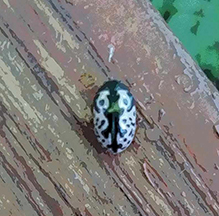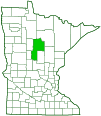unknown leaf beetle
(Calligrapha ignota)
Conservation • Description • Habitat • Ecology • Distribution • Taxonomy
|
|
||||||||||||||
Description |
Unknown leaf beetle (yes, that really is its common name) is a medium-sized calligrapher beetle. The species epithet ignota is Latin for “unknown”, and that is the source of the common name for this beetle. It occurs in the United States from Maine to Connecticut, west to Minnesota and Ohio, and south along the Appalachian Mountains to northern South Carolina and Tennessee. It also occurs in southern Canada from Nova Scotia to Manitoba. Adults are found from April to September in deciduous and mixed forests and woodlands. Both adults and larvae feed on the leaves of birch trees. Adults are 5⁄16″ to ⅜″ (7.5 to 9.5 mm) in length. The body is elongated-oval when viewed from above and very convex when viewed from the side. It is mostly creamy white with dark markings. The head, exoskeletal plate covering the first segment of the thorax (pronotum), and dark markings on the hardened wing covers (elytra) are black with a metallic green sheen (dark). The head is dark and is usually partially visible when viewed from above, but it can be withdrawn into the body. The antennae are short, less than half as long as the body. They are slender and have 11 segments. They are weakly expanded (clubbed) beyond the fifth segment, gradually enlarged as they approach the tip. The eyes are not notched. The pronotum is dark and unmarked. It is three times wider than long, nearly as wide as the base of the elytra. The small triangular plate between the bases of the elytra (scutellum) is dark. The elytra are creamy white with 3 dark stripes and 10 or more isolated dark spots. The markings are variable, and they have been named as an aid to identification of the species in this genus. The stripes include: a complete stripe on the inner margin (sutural stripe); a complete stripe near the inner margin (subsutural stripe); and a short, curved stripe (arcuate stripe). The arcuate stripe has a front (basal) lobe and a rear (apical) lobe. The spots include: a boot-shaped spot near the base in the shoulder area (humeral spot); a spot near the outer margin at the halfway point (midlateral spot), a spot near the rear on the downward slope of the elytron (spot of apical declivity); and a spot near the tip (apical spot). The subsutural stripe merges with the sutural stripe. When the arcuate band is divided into two separate spots, the subsutural stripe merges usually with the basal spot, sometimes with the top spot, sometimes with both. The midlateral spot is present. The turned under lateral edge of each elytron (epipleuron) is blackish with a metallic sheen. The legs are brownish-orange. The last part of each leg (tarsus), corresponding to the foot, has five segments. The fourth segment is very short and is concealed within the broadened tip of the third segment, making the tarsus appear to have only four segments. There is a pair of claws at the tip of the tarsus on each leg. The claws are well separated at the base. |
Size |
Total length: 5⁄16″ to ⅜″ (7.5 to 9.5 mm) |
Similar Species |
This is the only species in the Calligrapha scalaris group that has black epipleura and that feeds on birch. Hop-hornbeam leaf beetle (Calligrapha ostryae) has brown epipleura and feeds on hop-hornbeam. It does not occur in Minnesota. All other species in the group have pale epipleura. |
Habitat |
Deciduous and mixed forests and woodlands |
Ecology |
Season |
April to September |
Behavior |
Adults chew holes in leaves. Larvae consume the entire leaf except for the veins. |
Life Cycle |
|
Larva Food |
Leaves of birch trees |
Adult Food |
Leaves of birch trees |
Distribution |
||
|
Sources Gómez-Zurita, Jesús. 2005. New distribution records and biogeography of Calligrapha species, (Leaf Beetles), in North America (Coleoptera: Chrysomelidae, Chrysomelinae). Canadian Field-Naturalist 119(1): 88-100. Calligrapha ignota is much more common than this map, and distribution maps from other sources, would suggest. Many sightings, including specimens in museum collections, are believed to be misidentified as Calligrapha scalaris. |
|
| 8/25/2024 | ||
Occurrence |
||
|
||
Taxonomy |
|
Order |
Coleoptera (Beetles) |
Suborder |
Polyphaga (Water, Rove, Scarab, Long-horned, Leaf, and Snout Beetles) |
Infraorder |
Cucujiformia |
Superfamily |
Chrysomeloidea (leaf beetles and allies) |
Family |
Chrysomelidae (leaf beetles) |
Subfamily |
Chrysomelinae (broad-bodied leaf beetles) |
Tribe |
Doryphorini |
Subtribe |
Doryphorina |
Genus |
Calligrapha (calligrapher beetles) |
Subgenus |
Calligrapha |
no rank |
|
Tribe Species group In 1945, W. J. Brown identified a species complex of several species that were morphologically very similar but had very different host preferences and ecologies. A more recent study (Gómez-Zurita J., 2015) analyzed the original material from the Calligrapha scalaris collections of LeConte (1824) and of G. H. Horn (1884). The author found the collections contained as many as nine distinct species, many having no association with elm. He redefined the original species and defined fourteen species as the “Calligrapha scalaris” group. |
|
Subordinate Taxa |
|
|
|
Synonyms |
|
|
|
Common Names |
|
unknown leaf beetle |
|
Glossary
Elytra
The hardened or leathery forewings of beetles used to protect the fragile hindwings, which are used for flying. Singular: elytron.
Epipleuron
On beetles: The prominent, turned down or turned under, lateral edge of an elytron. Plural: epipleura.
Pronotum
The exoskeletal plate on the upper side of the first segment of the thorax of an insect.
Scutellum
The exoskeletal plate covering the rearward (posterior) part of the middle segment of the thorax in some insects. In Coleoptera, Hemiptera, and Homoptera, the dorsal, often triangular plate behind the pronotum and between the bases of the front wings. In Diptera, the exoskeletal plate between the abdomen and the thorax.
Tarsus
On insects, the last two to five subdivisions of the leg, attached to the tibia; the foot. On spiders, the last segment of the leg. Plural: tarsi.
What’s in a Name?
The species epithet ignota is Latin for “unknown”, and that is the source of the common name for this beetle.
Visitor Photos |
||
Share your photo of this insect. |
||
This button not working for you? |
||
 |
 |
|
| Found on boxelder. |
|
|
 |
||
| … found on my deck railing. |
|
|
MinnesotaSeasons.com Photos |
||
|
||
|

Slideshows |
|

Visitor Videos |
||
Share your video of this insect. |
||
This button not working for you? |
||
|
Other Videos |
||
|

Visitor Sightings |
||
Report a sighting of this insect. |
||
This button not working for you? |
||
Luciearl |
Location: Lake Shore, MN Found on boxelder. |
 |
| Luciearl 9/20/2023 |
Location: Lake Shore … found on my deck railing. |
 |
MinnesotaSeasons.com Sightings |
||
|

Created: 10/24/2023 Last Updated: © MinnesotaSeasons.com. All rights reserved. |
